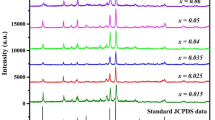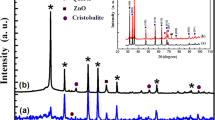Abstract
Metal nanoparticles and their binary oxides are well-known for their interactions with biomolecules and their applications in the biomedical field. However, the potential of ternary oxide nanophosphors remains underexplored in these fields due to challenges associated with high-temperature synthesis procedures and the use of toxic chemicals. ZnAl2O4, a ternary oxide matrix, being recognized for its adjustable wide bandgap, impressive surface properties, mechanical strength, thermal stability, and high quantum yield, is chosen for the present work. This study aims to comprehensively investigate the structural, morphological, optical, and cytotoxic properties of zinc aluminate nano phosphors synthesized through a co-precipitation method followed by low-temperature calcination. Analysis using X-ray diffraction spectroscopy (XRD) and Fourier-transform infrared spectroscopy (FTIR) revealed that the formation of the ZnAl2O4 spinel phase initiates at 300 °C and completes at 750 °C.SEM-EDAX measurements provided further confirmation of the compositional integrity of the synthesized sample. The average crystallite size, determined to be 11.47 nm through a W–H plot, along with a higher bandgap value of 4.49 eV compared to bulk ZnAl2O4 from the diffuse reflectance spectra (DRS), attests to the success of the nanophosphor synthesis. The self-activated blue luminescent centers of ZnAl2O4 can be fine-tuned to emit light in the green and red regions of the electromagnetic spectrum through appropriate rare earth (RE) do**, utilizing Tb3+ and Eu3+ respectively. Furthermore, the particles underwent short-term in-vitro cytotoxicity testing using Dalton’s Lymphoma Ascites cells (DLA) and normal cells, demonstrating high activity against DLA cells while maintaining compatibility with normal cells.








Similar content being viewed by others
Data Availability
No datasets were generated or analysed during the current study.
References
Song J, Leng M, Fu X, Liu J (2012) Synthesis and characterization of nanosized zinc aluminate spinel from a novel Zn-Al layered double hydroxide precursor. J Alloys Compd 543:142–146. https://doi.org/10.1016/j.jallcom.2012.07.111
Gildo-Ortiz L, Rodríguez-Betancourtt VM, Ramírez Ortega JA, Blanco-Alonso O (2023) An alternative approach for the synthesis of zinc aluminate nanoparticles for co and propane sensing applications. Chemosensors 11. https://doi.org/10.3390/chemosensors11020105
Tangcharoen T, T-thienprasert J, Kongmark C (2019) Effect of calcination temperature on structural and optical properties of MAl2O4 (M = Ni, Cu, Zn) aluminate spinel nanoparticles. J Adv Ceram 8:352–366. https://doi.org/10.1007/s40145-019-0317-5
Belyaev AV, Lelet MI, Kirillova NI et al (2018) Sol-gel synthesis and characterization of ZnAl 2 O 4 powders for transparent ceramics. Ceram Int 0–1. https://doi.org/10.1016/j.ceramint.2018.11.179
Saleem M, Varshney D (2017) In fl uence of transition metal Cr 2 þ do** on structural, electrical and optical properties of Mg-Zn aluminates. J Alloys Compd 708:397–403. https://doi.org/10.1016/j.jallcom.2017.03.016
Zhang Y, Huang R, Li H et al (2018) Germanium substitution endowing Cr3+-doped zinc aluminate phosphors with bright and super-long near-infrared persistent luminescence. Acta Mater 155:214–221. https://doi.org/10.1016/j.actamat.2018.06.020
Sunder S, Rohilla S, Kumar S, Aghamkar P (2011) Structural characterization of spinel zinc aluminate nanoparticles prepared by coprecipitation method. 123:123–125https://doi.org/10.1063/1.3653640
Sunder S, Singh W (2017) Thermal evolution of zinc aluminate spinel nanoparticles prepared by coprecipitation technique. International Journal of Scientific Research in Science, Engineering and Technology (IJSRSET) 3(8):1302–1315
Desissa TD, Meja M, Andoshe D et al (2021) Synthesis and characterizations of (Mg, Co, Ni, Cu, Zn)O high-entropy oxides. SN Appl Sci 3. https://doi.org/10.1007/s42452-021-04724-z
Ghosh S, Ghosh A, Pramanik S et al (2022) Synthesis of ZnO nanoparticles by co-precipitation technique and characterize the structural and optical properties of these nanoparticles. J Phys Conf Ser 2349. https://doi.org/10.1088/1742-6596/2349/1/012014
Battiston S, Rigo C, Da Cruz SE et al (2014) Synthesis of zinc aluminate (ZnAl2O4) Spinel and its application as photocatalyst. Mater Res 17:734–738. https://doi.org/10.1590/S1516-14392014005000073
Cheng B, Ouyang Z, Tian B et al (2013) Porous ZnAl 2 O 4 spinel nanorods: high sensitivity humidity sensors. Ceram Int 39:7379–7386. https://doi.org/10.1016/j.ceramint.2013.02.077
Sumathi S, Kavipriya A (2017) Structural, optical and photocatalytic activity of cerium doped zinc aluminate. Solid State Sci 65:52–60. https://doi.org/10.1016/j.solidstatesciences.2017.01.003
Farhadi S, Panahandehjoo S (2010) Spinel-type zinc aluminate (ZnAl2O4) nanoparticles prepared by the co-precipitation method: a novel, green and recyclable heterogeneous catalyst for the acetylation of amines, alcohols and phenols under solvent-free conditions. Appl Catal A Gen 382:293–302. https://doi.org/10.1016/j.apcata.2010.05.005
Abd-Allah AA, Ahmed YMZ, El-Sheikh SM et al (2022) Synthesis of Zinc aluminate nanoparticles from aluminum / zinc sludge for degradation of brilliant cresyl blue under visible light irradiation. J Water Environ Nanotechnol 7:288–305. https://doi.org/10.22090/jwent.2022.03.005
Saranya S, Vijayaranai K, Pavithra S et al (2017) In vitro cytotoxicity of zinc oxide, iron oxide and copper nanopowders prepared by green synthesis. Toxicol Rep 4:427–430. https://doi.org/10.1016/j.toxrep.2017.07.005
Khan MF, Siddiqui S, Zia Q et al (2021) Characterization and in vitro cytotoxic assessment of zinc oxide nano-particles in human epidermoid carcinoma cells. J Environ Chem Eng 9:105636. https://doi.org/10.1016/j.jece.2021.105636
Zadeh FA, Bokov DO, Salahdin OD et al (2022) Cytotoxicity evaluation of environmentally friendly synthesis copper/zinc bimetallic nanoparticles on MCF-7 cancer cells. Rend Lincei 33:441–447. https://doi.org/10.1007/s12210-022-01064-x
Hamdy DA, Ismail MAM, El-Askary HM et al (2023) Newly fabricated zinc oxide nanoparticles loaded materials for therapeutic nano delivery in experimental cryptosporidiosis. Sci Rep 13:1–19. https://doi.org/10.1038/s41598-023-46260-3
Su Y, Cockerill I, Wang Y et al (2019) Zinc-based biomaterials for regeneration and therapy. Trends Biotechnol 37:428–441. https://doi.org/10.1016/j.tibtech.2018.10.009
Vinitha N, Baby J, Krishna KM (2019) Effect of annealing temperature on the structure of a ternary aluminate phosphor synthesized via co-precipitation. AIP Conf Proc 2082. https://doi.org/10.1063/1.5093852
Abd-Allah A, Amin A, Youssef A, Ahmed Y (2022) Fabrication of zinc aluminate (ZnAl2O4) nanoparticles from solid industrial wastes. Egypt J Pure Appl Sci 60:14–26. https://doi.org/10.21608/ejaps.2022.132250.1032
Sarkar S, Das R (2018) Determination of structural elements of synthesized silver nano-hexagon from X-ray diffraction analysis. Indian J Pure Appl Phys 56:765–772
Visinescu D, Jurca B, Ianculescu A, Carp O (2011) Starch – a suitable fuel in new low-temperature combustion-based synthesis of zinc aluminate oxides. Polyhedron 30:2824–2831. https://doi.org/10.1016/j.poly.2011.08.006
Priya R, Negi A, Singla S, Pandey OP (2020) Luminescent studies of Eu doped ZnAl2O4 spinels synthesized by low-temperature combustion route. Optik (Stuttg) 204:164173. https://doi.org/10.1016/j.ijleo.2020.164173
Didde S, Dubey RS, Panda SK, Babu GS (2022) Experimental study of doped zinc aluminate nanoparticles by bottom-up approach for microstrip patch antenna applications. J Mater Sci 57:21069–21079. https://doi.org/10.1007/s10853-022-07929-8
Jamil Y, Jeyakumar GP, Deivasigamani G (2023) Investigation of transition metal ions Cu2+ and Mg2+ doped zinc aluminate (ZnAl2O4) and their structural, spectral, optical, and dielectric study for high-frequency applications. 2. https://doi.org/10.3390/iocn2023-14478
García-Hipólito M, Hernández-Pérez CD, Alvarez-Fregoso O et al (2003) Characterization of europium doped zinc aluminate luminescent coatings synthesized by ultrasonic spray pyrolysis process. Opt Mater (Amst) 22:345–351. https://doi.org/10.1016/S0925-3467(02)00346-4
García-Hipólito M, Corona-Ocampo A, Alvarez-Fregoso O et al (2004) Characterization of ZnAl2O4: Tb luminescent films deposited by ultrasonic spray pyrolysis technique. Phys Status Solidi Appl Res 201:72–79. https://doi.org/10.1002/pssa.200306692
Mahajan R, Kumar S, Prakash R, Kumar V (2018) Synthesis and luminescent properties of Sm3+ doped zinc aluminate phosphor. AIP Conf Proc 1953:2–6. https://doi.org/10.1063/1.5032544
Gahane NM, Chaware PJ, Rewatkar KG (2023) Structural, morphological, and photoluminescence study of Europium doped spinel ZnAl2O4 phosphors. Int J Chem Math Phys 7:01–06. https://doi.org/10.22161/ijcmp.7.1.1
Zhang D, Zhu B, Ren S et al (2021) The white light caused by defects and complex cation distribution in ZnAl2-xFexO4 magnetic nanocrystals. Mater Res Exp 8. https://doi.org/10.1088/2053-1591/abe017
Krishna KM, Anoop G, Jayaraj MK (2007) Host Sensitized White Luminescence from ZnGa[sub 2]O[sub 4]:Dy[sup 3+] Phosphor. J Electrochem Soc 154:J310. https://doi.org/10.1149/1.2766607
Acknowledgements
The authors gratefully acknowledge the financial support provided under DST-FIST (Grant No. SR/FST/College-046/2011), DST-CURIE (DST/CURIE-PG/2022/33) and DBT-STAR (Grant No. 102/IFD/SAN/3988/201-20, dated 29.02.2020) for the research facilities at the host institution. The authors also wish to thank Amala Cancer Research Centre, Thrissur, St Thomas College, Thrissur and STIC, CUSAT for the characterization facilities provided. One of the authors (VN) wishes to thank KSCSTE for funding the research through the KSCSTE Research Fellowship (No.42/FSHP/2016/KSCSTE, dated 24.03.2017).
Author information
Authors and Affiliations
Contributions
N conceived and designed the analysis, collected the data, performed the analysis and wrote the paper. R investigated the results and reviewed the paper. K performed the supervision, review and editing.
Corresponding author
Ethics declarations
Ethics Approval and Consent to Participate
Not applicable.
Consent for Publication
Not applicable.
Competing Interests
The authors declare no competing interests.
Additional information
Publisher's Note
Springer Nature remains neutral with regard to jurisdictional claims in published maps and institutional affiliations.
Rights and permissions
Springer Nature or its licensor (e.g. a society or other partner) holds exclusive rights to this article under a publishing agreement with the author(s) or other rightsholder(s); author self-archiving of the accepted manuscript version of this article is solely governed by the terms of such publishing agreement and applicable law.
About this article
Cite this article
N, V., R, R. & K, M.K. Low-temperature Co-precipitation Synthesis of ZnAl2O4 Nanophosphors Probing its Luminescent, Antibacterial and Anticancer Potentials. J Fluoresc (2024). https://doi.org/10.1007/s10895-024-03814-6
Received:
Accepted:
Published:
DOI: https://doi.org/10.1007/s10895-024-03814-6




